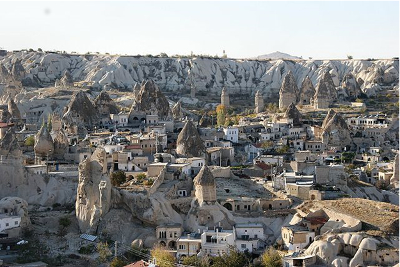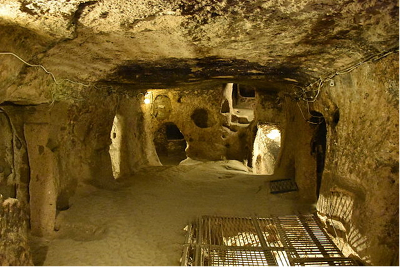Cappadocia is a district of Anatolia, Turkey. It lies roughly in the center of the country, in an area once blanketed by volcanic ash. While the ash eventually hardened into rock, it remained soft enough to be easily sculpted by both man and nature. Cappadocia is known for the otherworldly landscapes formed by the natural erosion of this material. The district is replete with “fairy chimney” rock towers, cones, valleys, and caves. It also has a rich Byzantine history.
 Plagued by invaders, the locals carved out at least 250 subsurface towns from the area's volcanic tuff. The underground cities included up to eight levels of rock-cut dwellings, churches, stables, and storehouses. They were likely created in the 4th - 10th centuries C.E. Early Christians escaping persecution also used the structures as hideouts and monasteries. These residents adorned church walls with Byzantine frescoes featuring images of Jesus and Christian saints. The faces in some of these images were later chiseled off during the Iconoclastic period that disapproved of the use of religious portraits, or icons. Instead, churches featured geometric patterns and crosses painted in red ochre during this period.
Plagued by invaders, the locals carved out at least 250 subsurface towns from the area's volcanic tuff. The underground cities included up to eight levels of rock-cut dwellings, churches, stables, and storehouses. They were likely created in the 4th - 10th centuries C.E. Early Christians escaping persecution also used the structures as hideouts and monasteries. These residents adorned church walls with Byzantine frescoes featuring images of Jesus and Christian saints. The faces in some of these images were later chiseled off during the Iconoclastic period that disapproved of the use of religious portraits, or icons. Instead, churches featured geometric patterns and crosses painted in red ochre during this period.

The city of Kaymakli is the widest such settlement. Built during the ninth and 10th centuries, it was equipped with ventilation shafts, chapels, a kitchen, and even wineries. However, Göreme is perhaps the most famous settlement. Göreme is an Open Air Museum and Turkish National Park that was likely a monastic complex. It contains eleven dining halls with rock-cut tables and benches, as well as several churches decorated with well-preserved Christian artwork. Most of the churches in Goreme Open Air Museum date back to the 10th - 12th centuries; some of these once contained tombs. The Karanlık Kilise is the best-known church at Göreme, due to its exceptionally vivid, well-preserved frescoes depicting Christ as Pantocrator, Christ on the cross, and the Betrayal by Judas.
Christian Greeks continued to live in the underground settlements until the government expelled them in 1923. However, some of the cave dwellings are still used as homes or hotels. Göreme National Park and the Rock Sites of Cappadocia were designated a UNESCO World Heritage Site in 1985.
Photo credits:
Homes in Cappadocia. Wikipedia. Creative Commons License.
Room in Kaymakli underground city. MusikAnimal. CC BY-SA 4.0.